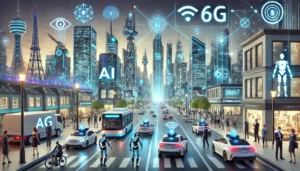Table of Contents
ToggleIntroduction

The rise of foldable and flexible displays
Enhanced screen real state without bulkiness
Foldable and flexible displays are revolutionizing the smartphone industry by offering users larger screens without compromising on portability. These innovative displays can expand to provide a tablet-like experience and fold back into a compact form for easy carrying. This dual functionality addresses the long-standing trade-off between screen size and device pocketability.
|
Feature |
Traditional Smartphone |
Foldable Smartphone |
|
Screen Size |
Fixed (typically 5-6.5 inches) |
Expandable (up to 8+ inches) |
|
Portability |
High |
High (when folded) |
|
Multitasking |
Limited |
Enhanced |
|
Form Factor |
Rigid |
Flexible |
Improved multitasking capabilities
Improvement of Multitasking abilities has changed the mobile-using experience:
- Split-Screen Functionality: Run multiple apps side-by-side
- Drag-and-drop between apps: Seamlessly transfer content
- Floating Windows: Keep smaller apps visible while using full-screen applications
Innovative form factors and designs
Flexible display technology has sparked a renaissance in smartphone design, leading to various innovative form factors:
- Inward-folding devices (like Samsung Galaxy Z Fold series)
- Outward-folding devices (like Huawei Mate X series)
- Rollable displays (concept devices from LG and Oppo)
These new designs not only offer functional benefits but also cater to users’ desire for unique and eye-catching devices. As the technology matures, we can expect even more creative and practical form factors to emerge, further challenging the traditional smartphone paradigm
Advancements in wearable technology
Smartwatches with expanded functionality
Smartwatches have developed from basic fitness trackers to sophisticated computers that are worn on the wrist. Today’s smartwatches offer features that rival traditional smartphones, including:
- Cellular connectivity
- Voice assistants
- Mobile payments
- Health monitoring
- App ecosystems
Feature: Traditional Smartphone Vs Modern Smartwatch
|
Calls |
Primary function |
Fully supported |
|
Texting |
Full keyboard |
Voice-to-text |
|
Apps |
Extensive library |
Growing selection |
|
Display |
Large touchscreen |
Compact touchscreen |
|
Battery |
1-2 days |
2-7 days |
Latest Smartphone Releases 2025
If you are looking for the best smartphone for photography then Galaxy S25 Ultra, Pixel 9 Pro, Phone 16 Pro, Xiaomi 15 Ultra are a great choice.
To avail extra off on your purchase click here.
Augmented reality glasses
The augmented reality glasses provides ease and enhanced experiences:
- Hands-free navigation
- Real-time information display
- Virtual workspaces
- Enhanced gaming experiences
Smart clothing and accessories are integrating technology seamlessly into our daily lives:
- Smart fabrics with embedded sensors
- Rings and pendants for contactless payments
- Connected shoes for fitness tracking
- Smart earbuds with language translation
Integration with health monitoring systems
Wearable devices are becoming crucial tools for personal health management. They offer continuous monitoring of vital signs and can integrate with broader health systems:
- Real-time heart rate and ECG monitoring
- Sleep tracking and analysis
- Stress level assessment
- Integration with electronic health records
As wearable technology continues to advance, it’s clear that many functions traditionally performed by smartphones are being distributed across various devices, potentially reducing our reliance on traditional handheld devices.
Autonomous Vehicles: Driverless Cars Hit the Streets
Autonomous driving technology has reached full maturity in 2025. Commercially available Level 5 autonomous vehicles don’t need human assistance. Key advancements include:
Enhanced AI Navigation: Vehicles employ AI to comprehend complex traffic patterns and make split-second decisions.
Vehicle-to-Everything (V2X) Communication: Cars communicate with infrastructure, pedestrians, and other vehicles for improved safety and traffic flow.
Electric and Sustainable: Most autonomous vehicles are electric, reducing carbon emissions and improving urban air quality.
Companies like Tesla, Waymo, and legacy automakers are competing to dominate the autonomous vehicle market.
Biotechnology and Genetic Engineering: Editing Life Itself

CRISPR and other gene-editing technologies have seen remarkable progress in 2025. Scientists are now able to:
Eliminate Genetic Diseases: Precision editing of human DNA allows for the eradication of inherited conditions.
Synthetic Organ Growth: 3D-printed organs using patient-specific cells are reducing transplant waiting times.
Gene-Driven Therapies: Personalized medicine based on genetic profiles is improving treatment outcomes for cancer and autoimmune diseases.
The ethical implications of genetic editing continue to be debated globally, but the potential for medical breakthroughs is undeniable.
Blurring the Boundaries Between Virtual and Real Worlds with Extended Reality (XR)
The developments of Tchnologies in 2025 include:
- Immersive Workspaces: XR-based virtual offices enable seamless remote collaboration.
- Entertainment and Gaming: Fully immersive VR experiences with haptic feedback provide a new level of realism.
- Education and Training: XR simulations are enhancing medical training, military exercises, and technical skills.
Big tech companies like Meta, Apple, and Microsoft are leading the charge in XR development.
7. Blockchain and Web3: The Decentralized Internet Takes Over
Blockchain technology and Web3 are transforming the internet into a decentralized ecosystem. Major trends include:
- Decentralized Finance (DeFi): Peer-to-peer lending, smart contracts, and tokenized assets are reshaping the financial landscape.
- Non-Fungible Tokens (NFTs): Digital ownership extends beyond art into real estate, music, and intellectual property.
- Decentralized Social Networks: Users regain control over their data and privacy through blockchain-based platforms.
Web3 is empowering individuals and reducing the influence of centralized corporations.
Robotics and Automation: Smart Machines in Every Industry
Advanced robotics and automation systems are transforming manufacturing, healthcare, and agriculture. Key innovations include:
- Collaborative Robots (Cobots): Robots working alongside human operators to improve productivity.
- Automated Warehousing: AI-driven robots manage inventory and fulfill orders with high efficiency.
Robotics is increasing efficiency and reducing costs across industries.
Sustainable Tech: Green Innovation for a Better Future
Sustainability remains a key focus in 2025. Technology is driving solutions to combat climate change and reduce environmental impact, including:
- Carbon Capture: AI-driven carbon capture systems are reducing industrial emissions.
- Renewable Energy Storage: High-capacity batteries and smart grids enable reliable energy distribution.
- Eco-Friendly Materials: Biodegradable plastics and sustainable manufacturing processes are becoming mainstream.
Governments and corporations are investing heavily in green technology.
Space technology has seen rapid advancements in 2025. Major milestones include:
- Commercial Space Travel: Private companies like SpaceX and Blue Origin offer affordable space tourism.
- Lunar and Martian Colonies: Permanent human settlements on the Moon and Mars are under development.
- Asteroid Mining: Extraction of rare metals from asteroids is creating new economic opportunities.
Space exploration is entering a new golden age, with international collaboration driving progress.
Conclusion
The year 2025 is going to be a unique year in terms of tech news. While technology has taken over the entire market, new technologies are emerging every day.
In every field, be it biotechnology or the automobile industry, there are amazing technologies emerging every day which are quite innovative and modern.



